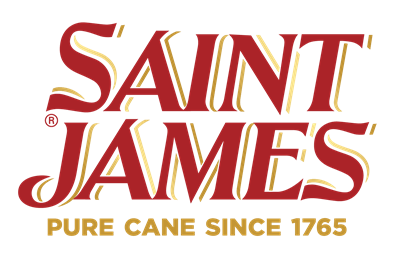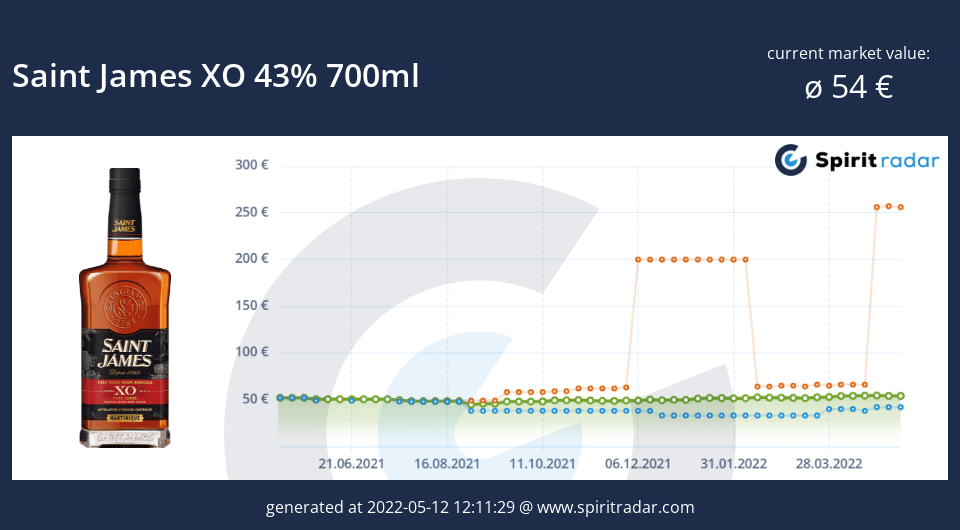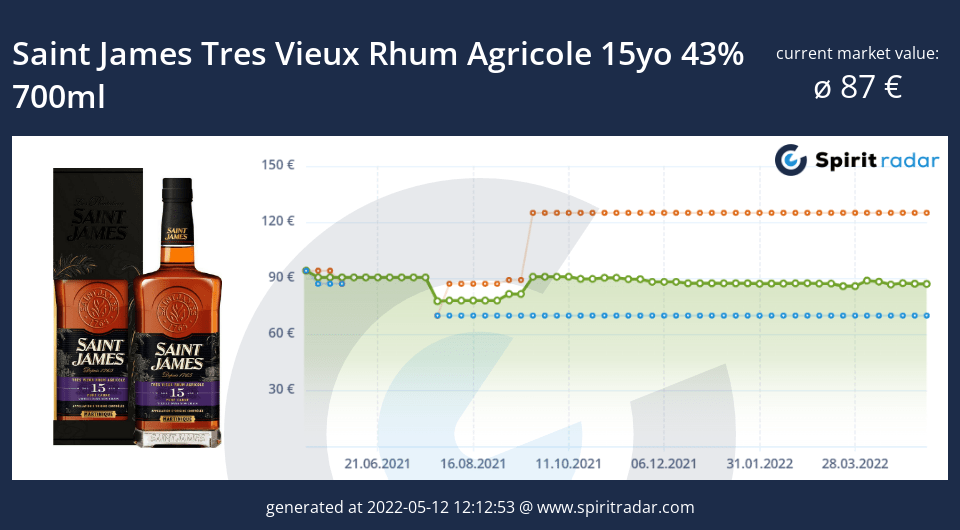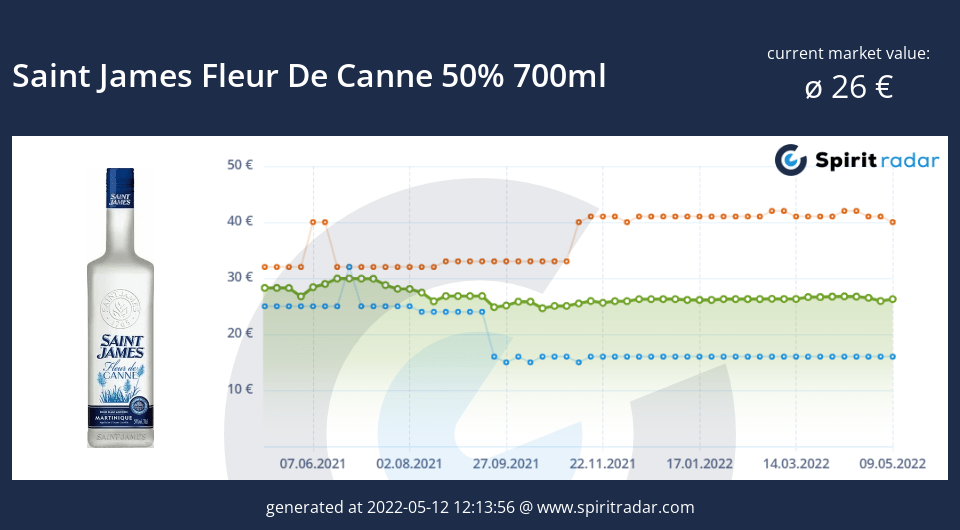
Saint James was founded in 1765 in Saint-Pierre de la Martinique due to Reverend Father Edmund Lefebure. This honorable friar created white alcohol of unparalleled quality, a cane spirit known as "Guildive" or "Tafia."
Despite vigorous French protectionism, King Louis XV allowed Martinique to export its rum in 1763. New England, the first state of today's the United States, was the only nation capable of purchasing the rum at the time.
In 1765 was agreed to name the rum "Saint James", a term with a strong Anglo-Saxon consonance and the name of a large, renowned family in the United Kingdom, to make it simpler to sell to New England settlers. Unfortunately, the Montagne Pelee volcano erupted on May 8, 1902, destroying Saint-Pierre and the site of Saint James. All production was relocated to Sainte-Marie in 1974.
Official website: rhum-saintjames.com
The Saint James distillery is a "smoking" distillery, which means it's still in operation. The Saint James trademark was registered in 1882, along with the world's first square bottle, designed for sensible and secure storage in the holds of maritime boats, reducing breaking during storms.
The Saint James Rums strictly adhere to the Appellation d'Origine Controlee "Rum Agricole Martinique" criteria. The manufacturing process is closely monitored to achieve this.
Sugar cane is grown on the eastern slope of the Montagne Pelee and enjoys a favorable geographical and geological location, with volcanic soil giving fertile terrain, abundant sunshine, and a humid tropical environment swept by Atlantic Ocean spindrift carried by a trade wind. Cane harvesting starts in February and lasts for about five to six months. According to an old Martinique saying, the cane is then hurriedly transported to the distillery: "The cane must have its feet on the earth and its head in the mill," according to an old Martinique saying. Then, in order to retain the sugar content and smells of sugarcane, it must be processed quickly.
The cane is squeezed at a low temperature after it arrives at the distillery. The juice, or "Vesou," is the end result, which will be left to ferment at a temperature of 25 to 30 degrees Celsius.
The fermenting process takes 24 to 48 hours, yielding "sugarcane wine" with a 4 to 5% alcohol content. The "sugarcane wine" is then boiled in copper columns, with an alcohol level of 65 to 74 percent by volume due to this distillation (abv).
All Saint James rums are made from sugar cane juice that has been fermented and distilled. The Saint James rums benefit from this unique production procedure. It imparts an aromatic aroma and a fruity flavor, making them ideal for aging in oak casks like the best brandies.
Interesting Facts About Saint James
The first rum distilled at Martinique's "Habitation Trou Vaillant" was sold to North America in 1765 under the name Rhum Saint James. Martinique became one of the Caribbean's most prolific "sugar islands" in 1765. By Louis XV's request, the Brothers of Charity managed the Fort Saint-Pierre hospital on the island's west coast, at the foot of Mount Pelée, principally to care for wounded warriors and others in need.
Father Edmond Lefébure, the Superior of the Order, had a sugar refinery erected next door, at "Trou Vaillant," to meet the hospital's demands. The sugar refinery, as is customary, led to the establishment of a vinegar plant, where the molasses wastes were distilled to produce "guildive" or "tafia."
Both famous botanists, Father du Tertre and Father Labat, had already studied the distillation process and had stills sent over from France to increase the quality of these very rustic alcoholic beverages that were the stuff of pirates and servants.
Paulin Lambert bought "Habitation Trou Vaillant" and registered the Saint James brand, known for its iconic square bottle. Religious domains in the colonies were proclaimed national property belonging to the state after the Revolution and up until 1820.
These deeds were revoked by royal edict in 1820, during the Restoration. This return to normal allowed Paulin Lambert, a Marseille dealer, to focus on rum manufacturing in Martinique. Saint-Pierre had established itself as the world's foremost rum port, and manufacturing was beginning to become more organized.
Small sugar refineries were going out of business, leaving only the larger ones with "Creole" distillation columns (continuous distillation). Paulin Lambert eventually bought a number of "Habitations," including "Trou Vaillant." Was he already aware of "Saint James" potential? A name that sounded English opened up huge possibilities.
The first vintage of Saint James 1885 was released. Rare bottles are still maintained in the Distillery's Vintages Cellar to this day. A key feature for the time: Paulin Lambert ensured that his product stood out from the competition from the start, referring to it as "Saint James", the foremost Agricole rum from the French West Indies." This shows that instead of molasses, he was using "vesou" (fresh sugar cane juice).
The trader went even further in his strategy, deciding in 1885 to provide vintage rum to his discerning clients. At a time when rum was generally blended, this was a unique initiative. This would be the first in a long line of vintages. Furthermore, Paulin Lambert was a gifted communicator. He didn't conceal his enthusiasm for his rum, which was "recommended by medical specialists the world over" on his billboards.
On the high terrain above Saint-Pierre in 1889, he erected a banner measuring thirty meters by four meters that read "Plantations Saint James." This sign served as a navigational aid for sailors and a welcoming message to anyone who arrived on the island.
From 1895 forward, Saint James expanded rapidly, operating stores in the world's most populous cities.

This liquid gold will surprise you with a delicate, velvety texture and a well-balanced palate of spice, citrus peel, and licorice, this blend of rums aged between six and ten years offers impressive richness and depth.
Sugarcane juice rum, also known as Rhum Agricole, was first distilled from freshly extracted sugarcane juice in the French Caribbean islands rather than molasses. Rhum is the term used in French-speaking areas to distinguish it from molasses-based rum found elsewhere in the West Indies.

This agricultural rum, aged 15 years in the tropical climate of Martinique, is a Saint James distillery classic. The angels' share is 60% (the portion evaporated from the original rum at the start of maturing) and indicates a high concentration of smells.
Its notes of exquisite wood come from the meticulous aging process. Spices, tobacco, and cooked fruits will all be available. The mocha finish adds an appealing level of depth and balance to this rum.

Saint-James Fleur de Canne gives a rich fragrance pallet for tasting or preparing the classic punch. The scents of Martinique's land and sun are concentrated in this white agricultural rum, which is created from sugar cane cut during the dry season.
This rum's quality earned it a silver medal at the 2013 Concours Général Agricole de Paris. Saint-James Fleur de Canne earned a gold medal at the Concours Mondial de Bruxelles the same year.